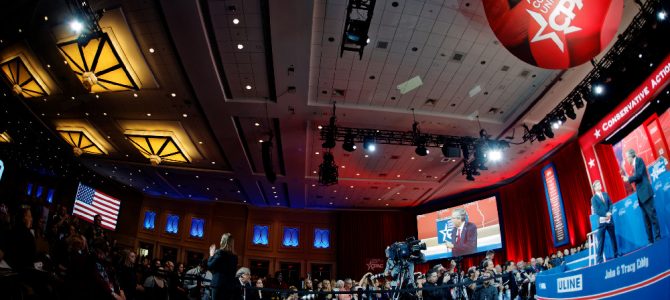
The ouster of Bill O’Reilly from his flagship spot at the Fox News Channel has sparked a conversation about the nature of his appeal, particularly as after the fact many viewed O’Reilly’s success as foretelling President Trump’s political victories. Much of this conversation has focused on sketching the limits of O’Reilly’s appeal, perhaps because it has been driven by writers who are not reflexive Trump supporters.
For example, National Review’s Ian Tuttle argues O’Reilly’s appeal exposed a generational divide separating younger conservatives such as Ben Shapiro, Katie Pavlich, and Ben Domenech from Fox staples like O’Reilly and Sean Hannity. The former came of political age when Reagan Republicanism represented the status quo, while the latter’s fans were shaped by the era before Reagan.
Nevertheless, Tuttle also touched on the idea of the pugnacious Trump/Fox News style trickling down to some younger pundits or provocateurs affiliated with the Right. David French focuses on this, identifying Tomi Lauren and Milo Yiannopoulos as examples of a “toxic culture of conservative celebrity, where the public elevated personalities more because of their pugnaciousness than anything else,” not unlike the Left celebrates entertainers such as Stephen Colbert. Since Colbert found celebrity parodying O’Reilly, we should savor the irony.
Jonah Goldberg attributes much of the current dynamic to right-wing envy of the supposedly successful left-wing tactics employed by radical community organizer Saul Alinsky. In our increasingly polarized political climate, Goldberg argues (as I have) that it is ultimately difficult to claim that “[o]ur ideology has a monopoly on virtue, but in order for virtue to triumph we must act like people we claim are virtueless.” He also worries that Tuttle underestimates the appeal ostensibly right-wing Alinskys have for young conservatives.
What, then, should we make of O’Reilly’s generational appeal, both in style and substance? How much of that appeal translates to younger generations of the non-Left, and why?
Trump Types Are Nostaligic, the Young Engage Today
It was fairly clear from the outset that Trump-friendly voters are more comfortable with New Deal/Great Society America than “true conservatives” are. As Trump’s core supporters and Fox News viewers tend to skew older, Tuttle’s generational theory of “pre-Reagan vs. Reagan-era politics” likely holds water. The political overlay, however, is probably not the only one at work. After all, as the late Andrew Breitbart (among many) would observe, “culture is upstream of politics.”
Trump/O’Reilly fans are older cultural conservatives who tend to care less about the fiscal, religious, or even foreign policy concerns of Reagan-era republicanism. Trump/O’Reilly conservatism is very small-c, not only in not wanting existing New Deal and Great Society programs disrupted, but also in nostalgia for the cultural norms and mores of that period. The 2016 campaign certainly saw its share of analysis presenting Trump and Hillary Clinton as different strains of this nostalgia, e.g., the Rat Pack versus Woodstock.
Younger conservatives are often a different animal. As Domenech told The Fifth Estate podcast recently, his vision for The Federalist may be critical of progressives’ culture war, while remaining engaged with the culture writ large. Yet he is not interested in simply becoming a cultural scold.
I think similar attitudes in younger conservatives help explain the genius of FNC’s recently-departed “RedEye,” as well as the rocketing popularity of the Weekly Substandard podcast. The Substandard’s hosts are generally too young for the nostalgia of the disaffected cultural conservatives (nostalgia for “Ultraman” or “Star Blazers” is a different matter, even if millennials like Sonny Bunch may not get it).
Many Young Conservatives Also Want Cultural Sobriety
But Goldberg isn’t wrong in noting the appeal of cultural conservatism to at least a segment of younger conservatives. A number of factors help account for it.
First, there is the dumbing down of American education, especially regarding Western civilization. A deep understanding of traditional conservatism might require familiarity with John Locke, The Federalist Papers, comparative advantage, Frederic Bastiat’s “broken windows” theory, or even a bit of theology, for example. Not much background in theology is required to grasp the “War on Christmas,” let alone the attacks on freedom of speech and due process on college campuses, innocent people being murdered by illegal aliens, or the ever-increasing politicization of sports media.
Indeed, French’s “toxic culture of conservative celebrity” may be produced as politics and political media metastasize into tribalism and infotainment. The vacuum created by the disappearance of the traditional liberal arts curriculum gets filled by talk radio and cable news (talk radio with pictures). Mass-audience television and radio are suited to storytelling and conflict, and devolve to a focus on drama and characters, as anyone from CNN honcho Jeff Zucker to Trump himself could tell you. It is a manifestation of Marshall McLuhan’s adage that the medium is the message.
Given the educational factor, cultural conservatism may also be the sort most likely to be transmitted from parents to their children. When I was studying political science during the Reagan presidency, one’s parents’ politics were the most solid predictor of one’s own over time. I would bet that has not changed much; parenting matters, particularly in transmitting values.
Thanks for Handing Us a Trashed Inheritance
As the topic is generational politics, consider also the generational theories of William Strauss and Neil Howe, even if not as heavily as Trump adviser Stephen Bannon apparently does. In the Strauss and Howe typologies, millennials, like boomers, are generations ascendant during periods of upheaval (although arguably different types of upheaval). Millennials are generally the children of boomers, so it is not shocking that they may have a certain similarity of character.
The New New Left, then, may be largely the spawn of the original New Left. Young people who are not drawn to the New New Left are probably the children of those non-lefties who came of age when Nixon’s “silent majority” was beating the original New Left (however temporarily).
Some non-Left millennials may be attracted to the next iteration of Nixon/Wallace styles of politics, thus the attraction to pugnacity and perhaps even “dirty tricks.” The fighting spirit during a period of cultural or secular tumult transcends the politics in which it manifests.
Consider the journey of someone like David Horowitz: from red-diaper baby to radical leftist to guardian of the true conservative flame to (most recently) defender of Trump and his associates. The politics change greatly; the pugnacity remains the same. Other people will be more consistent in their politics, but their view on tactics may change. Still others will be consistent on both vision and tactics.
The tension between conservative ideology and “burn it down” tactics that concerns Goldberg (and me) is at least partially a product of a century of progressivism becoming the philosophy of the establishment. Traditionally, conservatism has been concerned in large part with preserving the worthwhile features of our institutions, while socialism has been concerned in no small part with marching through those institutions.
The issue non-leftists face is how to proceed now that the Left has been largely successful in marching through those institutions. Given the current state of affairs, it is perhaps not surprising that non-leftists, particularly young people, may see less value in conserving institutions that are at best failures and at worst adversarial to the ideas and values the Right ostensibly seeks to conserve.








